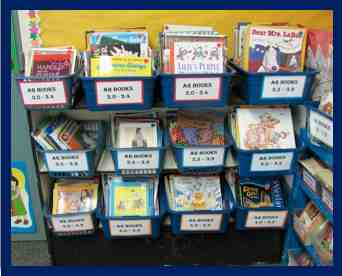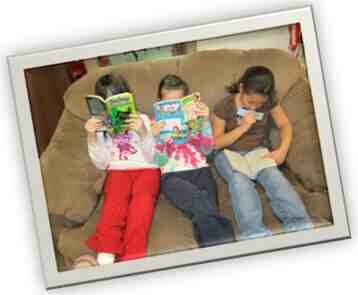By: Rita Platt
 Recently I was at a meeting for reading specialists when the concept of level-appropriate texts came up. Much to my surprise several of the specialists spoke up against sharing reading levels with students. I was shocked! Why in the world would we hide key information from the stakeholders most impacted by it? The reasons given for keeping students out of the knowledge loop was to save them from “feeling bad” about their level and to not “restrict” them to only reading at their level. Now I was double-shocked! Frankly, I thought that we’d left all of that nonsense behind in the era of America’s “self-esteem-in-education movement”. Practical teachers who are deeply concerned with helping students move forward as readers know that allowing students access to approximate level is an important tool. In fact, it is such an important tool that not allowing children to use it seems almost cruel. As one reading specialist put it, “If you were trying to lose weight, would it be fair for the doctor to hide the scale from you to save you from feeling bad?” No, it wouldn’t.
Recently I was at a meeting for reading specialists when the concept of level-appropriate texts came up. Much to my surprise several of the specialists spoke up against sharing reading levels with students. I was shocked! Why in the world would we hide key information from the stakeholders most impacted by it? The reasons given for keeping students out of the knowledge loop was to save them from “feeling bad” about their level and to not “restrict” them to only reading at their level. Now I was double-shocked! Frankly, I thought that we’d left all of that nonsense behind in the era of America’s “self-esteem-in-education movement”. Practical teachers who are deeply concerned with helping students move forward as readers know that allowing students access to approximate level is an important tool. In fact, it is such an important tool that not allowing children to use it seems almost cruel. As one reading specialist put it, “If you were trying to lose weight, would it be fair for the doctor to hide the scale from you to save you from feeling bad?” No, it wouldn’t.
What I heard at the reading specialist meeting wasn’t isolated. It turns out a bigger tide is coming. More and more I am hearing talk of not using readability levels to inform the choices teachers and students make about the reading children are asked or required to do. Of course, I’m not hearing it from actual classroom teachers but from various specialists and consultants. It is becoming a dull roar. I think it may all stem from dogmatic and somewhat misinterpreted readings of the Common Core Standards. With the Standards comes a new emphasis on the concept of “text complexity”. This is a good thing. All teachers should be working on their curriculum and with their students to insure that the reading students are doing is rigorous and learning-intensive in multiple ways. But it does not mean that teachers who level books need to throw out their systems. Practical professionals understand that the idea of “text complexity” is, well, complex. They also know that guiding students to books using quantitative leveling systems one helpful part of strategic system for helping children learn to read and read to learn.
Here begins the cautionary tale for administrators, consultants, reading specialists, and other school leaders. Don’t assume that your teachers aren’t savvy enough to understand that quantitative measures aren’t the only, or even most important, measure of complexity. Most of us are well aware of this fact.
Let’s start with the Common Core State Standards. The English language arts standards remind us that in order to be proficient readers student must be able to read texts with “appropriate grade-level complexity”. What exactly does that mean? Of course the concept of text complexity is a multifaceted matter. In a very simplistic way it can be defined as the interplay of three leveling factors; quantitative measures, qualitative measures, and professional judgment. Below is a nutshell definition for each of the factors.
- Quantitative factors are concerned with hard-data about text level including lexile, grade-equivalent, and many other systems from Degrees of Reading Powers to Fountas and Pinnel to DRA, etc.
- Qualitative factors include a less concrete set of measures including text-structures/features, genre, length, and sophistication of themes and ideas in the text.
- Professional judgment refers to teacher knowledge about choosing the right text for a given reader or group of readers. Here factors such as interest, engagement, and relevancy come into play.
For a deeper understanding link to the Common Core Standards (PDF) Appendix: A Supplemental Information: New Research on Text Complexity Also helpful are the sample texts (PDF) for each grade level.
 In reading the above descriptions of text complexity it should be clear that one aspect concerns matching books to readers based on pure and simple, old fashioned readability levels. Most elementary schools have some system for sharing quantitative book level. At the excellent elementary school where I work, we use Accelerated Reader and our books are coded with colored dots that denote ATOS level (in simple terms, ATOS is a grade-equivalent.) But, the dots are just one tool for choosing books. They are not the be-all-end-all in choosing books. We also teach students to use the following strategies to select what we call variously “just-right” or “just-fit” books. Before you read through the strategies I should share with you that we are a rural, full Title 1 school—about half of our students receive free and reduced lunch. We are also a school that “exceeds standards” on our state test, in other words, for the most part, what we do works.
In reading the above descriptions of text complexity it should be clear that one aspect concerns matching books to readers based on pure and simple, old fashioned readability levels. Most elementary schools have some system for sharing quantitative book level. At the excellent elementary school where I work, we use Accelerated Reader and our books are coded with colored dots that denote ATOS level (in simple terms, ATOS is a grade-equivalent.) But, the dots are just one tool for choosing books. They are not the be-all-end-all in choosing books. We also teach students to use the following strategies to select what we call variously “just-right” or “just-fit” books. Before you read through the strategies I should share with you that we are a rural, full Title 1 school—about half of our students receive free and reduced lunch. We are also a school that “exceeds standards” on our state test, in other words, for the most part, what we do works.
- The Five Finger Rule: We remind students that a color-dot is just a starting place. To really know if the book is at the right quantitative level a student needs to read a few pages, think about how many difficult words they encounter, and then decide on if it is an “easy”, “just-right”, or “hard” text. We then ask kids to follow a pattern of reading just-right, hard, just-right, easy, just-right, hard, just-right, easy books. Most of our students are diligent about doing so. Of course, we teach and model for students that “hard” doesn’t mean too hard and that easy doesn’t mean too easy. Vygotsky’s Zone of Proximal Development theory is every bit as relevant today as it was when it was first conceived. To learn independently, we must have books that are in that sweet spot between too easy and too hard.
- I-PICK: Adopted and adapted from the Daily 5 reading workshop model. Though the acronym feels a bit forced we still use the I-PICK lessons and posters. Students learn to evaluate the choices they make based on qualitative factors. I-PICK helps children remember that when picking a book interest, purpose for reading, and ability to read the words, are all important in finding a “just-right” read.
- Genre Studies:As the school librarian and reading specialist, I provide all students with multiple lessons on genre and most classroom teachers support these learnings by doing genre-studies in their own classrooms. All students are challenged to read across genres both in general and widely. We begin by asking first grade students to read fiction and nonfiction books in equal parts. In second grade we ask students to read the broad genres of picture books, novels, and nonfiction in equal measures. By the end of second grade and through third and fourth grade we regularly introduce new subgenres, including classics, and encourage students to read from each. Of course, subgenres are also focused on through teacher read alouds and content-area reading. In addition, many teachers use a “book bingo” record-sheet to help students widen their reading. These strategies help keep students and teachers alike aware of the qualitative factors involved in selecting “just-right” books.
- Routines for Deep Thinking About Reading: Every student is helped to work at reading for deep meaning. We begin by working with first grades to consider author’s message and to share explicit evidence from the text to support their thinking. We continue by working with students at all grade levels to think about, talk about, and write about themes, connections, and implications of what they read. Students are taught to use note-taking as a vehicle for understanding nonfiction informational texts
As for the last factor of text complexity, use of professional judgment, the most successful reading teachers at my school are all over it! They are in close touch with students’ reading strengths, interests, and needs. They engage in regular and varied assessing of growth in both quantitative and qualitative areas. They frequently do formal and informal conferring with students. They are often found in the library helping children pick that “just-right” book. They make the experience of reading a reward and a celebration and continually model their own interactions with texts of various types and levels of complexity.
Okay, now I feel like I’ve established the fact that I and many other teachers are acutely aware of and invested in working with students to read complex texts and that when we do so we gauge complexity based on quantitative, qualitative, and other professional judgments. Back to the question discussed at the beginning of this article: What possible reason could a practical teacher have for not sharing information about students’ personal reading level and the approximate readability level of books? None. In fact, an abundance of research in and out of the field of education is pointing to the idea that we must share basic data points with students and that doing so promotes motivation, self-esteem, and increased learning. Below I will share three reasons why we must share quantitative data about reading levels with students.
- When we are open and honest, or, “transparent”, in the common vernacular of the day, we do not cloak students in what I call “the veil of shame”. Here is the thing– almost all kids already know their approximate reading level, in fact almost all kids know the approximate reading level of every other child in their classrooms. We cannot hide it. What we can do is remind students that there is no shame in being where you are. Everyone is an individual and it is as crazy to expect every reader to be at the same level in much the same way it would be to expect every baby to walk or talk at exactly the same time.
I tell students that as long as they are working hard and making progress, they are right where they should be. I frequently remind children that the word “intelligence” has to do with how many connections you are making and NOT the reading level you are currently achieving. Children, for the most part, seem to get that. Recently I read a brilliant article on the incredible power of the word, yet. The idea is that we must all strive to remember, it is human nature to continually grow and learn. There is no shame in not being where you want to be, especially if you add the word yet. For example, “I am not at the reading level I want to be yet.” Just adding the word yet makes turns what could have been perceived to be negative into a positive goal-oriented statement. How cool is that?!
- To be motivated to grow and learn; students must be included in the data-based teaching model. Daniel Pink, a journalist and book author, wrote a fantastic book about motivation, Drive: The Surprising Truth About What Motivates Us. In it he describes the key elements that must be present in order to create an optimal environment for motivation, innovation, and growth. The elements are purpose, autonomy (in other words, ownership), and mastery. Sharing data, including reading levels is a critical component of building purpose, ownership, and ability to master new learnings. For more on this, please see my narrated PowerPoint Presentation: Data-Based Motivation. Similarly, Carol Dweck’s work on “mindset” teaches us that students should always be reminded that they have the ability to grow, learn, and change. That working toward growth can actually help them “grow” their intelligence. For more from Dweck, take a few minutes to watch her talking about her findings in the short but informative video found here.
- Last, and perhaps a retread of the first two points, is that hiding information from kids is unfair, unkind, and unnecessary. Again, when we hide things that most people already know, we make them “dirty little secrets”. That is simply a stigma we cannot afford to place on children. Students are the number one stakeholders in their own educations. They should be allowed access to basic information about their progress. Of course, I’m not talking about sharing percentile rankings or arcane information from the bevy of standardized tests we increasingly force on children and their teachers. I am talking about sharing basic, simple information that can help students think about their own learning.
As we all enter the new education climate, as we all begin to use the Common Core State Standards, and as we all adapt the even greater “accountability” measures in education, I urge caution. Especially from educational leaders. Look before you leap. Talk to teachers and students before rushing to “fix” systems that aren’t broken. The call for text complexity in no way is tantamount to a call for the end of leveled reading.
Rita Platt is a Nationally Board Certified teacher. Her experience includes teaching learners of all levels from kindergarten to graduate students. She currently is a Library Media Specialist for the St. Croix Falls SD in Wisconsin, teaches graduate courses for the Professional Development Institute, and consults with local school districts.
Featured Image Photo Credit: Salem (MA) Public Library via Compfight cc








Pingback: AR Killed My Dog ! A Defense of Accelerated Reader | We Teach We Learn
I see you don’t use the power of social websites like twitter and facebook on your site.
You can get huge traffic from social sites on autopilot using one useful app, for more info search
in google for:
Alufi’s Social Automation
Thank you for this valuable resource!
Great items from you, man. I’ve keep in mind your stuff prior to and you’re simply extremely
great. I really like what you have obtained right here, certainly like
what you’re saying and the way in which through which you
assert it. You make it entertaining and you continue to care for to keep it wise.
I cant wait to learn far more from you. That is really a wonderful site.